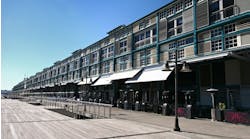Cleaning. Sanitizing. Disinfecting. These activities have always been critical when it comes to cleaning and floor care in healthcare facilities, commercial buildings and schools—and they are now more so than ever. The COVID-19 pandemic has resulted in the need to clean not just for the sake of appearance, but for health reasons.
In fact, cleaning has become more of an essential part of a facility’s operation than a line-item expense; it’s now part of the cost of doing business. Due to COVID-19, there is a greater awareness of germs and the overall health of a facility. Building service contractors and facility managers recognize that having a safe, thorough and visually appealing cleaning program plays a part in attracting and retaining employees, tenants and customers, as well as generating repeat visitors.
Because of that, the cleaning industry is seeing a trend away from the traditional mop-and-bucket approach and toward the use of mechanized cleaners. This technology has been prevalent in healthcare for some years but is starting to be adopted by other industries as well—and for good reason.
[Related: Tenants Are Aware of Your Building’s Hygiene]
Assessing the Mop and Bucket
For smaller building service contractors especially, the low cost of using mops and buckets is appealing. However, this approach to cleaning can generate more costs in the long term and it poses safety risks.
Dirty mop water leads to poor optics and can easily turn people away from a facility. That lost revenue adds up—whether it’s a matter of losing customers at a retail location or grocery store or tenants in an office space.
But there are more concerns about the use of mops and buckets than just poor aesthetics. Performance also suffers if strict dump and fill policies are not adhered to and closely monitored.
Cross-contamination is one of the biggest concerns. With every pass, dirt and contaminants from the floor adhere to the mop and are put back into the bucket, then reintroduced to the floor during the water/detergent cycle.
The process of mopping is also time-consuming and much less efficient than a mechanized solution. With time at a premium in any cleaning operation, using manual labor can set a building services contractor behind. It can also prevent their team from taking on additional tasks at a facility that could potentially generate more revenue.
Mopping and managing the dumping, rinsing and refilling process can cause undue strain on the back, arms and hands. Ergonomics needs to be considered in the decision of whether to continue this method of floor cleaning.
Last, mopping processes are often interrupted, which potentially introduces slip and fall risks due to wet floors. This can be a liability if a customer or tenant is injured.
The Value of Mechanized Cleaners
The use of automatic scrubbers is quickly challenging the age of mop and buckets in the industry. Automatic scrubbers dispense water and a cleaning solution at the brushes and removes the dirty water from the floor into a recovery tank.
Clean water with chemicals or chemical-free technology is used throughout the entire process. The vacuum suction and squeegee recovery process not only offers better optics for the customer, but also improves safety conditions by reducing slip and fall risks associated with wet floors.
Automatic scrubbers offer an improvement in ergonomics over cleaning with a mop and bucket, especially when building service contractors opt for a self-propelled machine.
The ability to enhance performance more than 10 times (compared to mopping) when utilizing mechanized cleaning methods also makes this equipment appealing.
[Related: How Unclean Restrooms Impact Students’ Perceptions of Your School]
The Mechanized Options
So, what equipment is available? That depends on the need.
The size of the space, the presence of shelving or other obstacles, and heavy-traffic areas, for example, all factor into the solution—particularly the size of scrubber.
Automatic scrubbers range in size from very small hand-held models to self-propelled walk-behinds, along with all sizes of ride-on and stand-on scrubbers. Newer autonomous mobile robots (AMRs) are also available.
There are corded, battery, propane and LPG options available. Various brushes and squeegees are also available to fit the type and smoothness of the floor, the presence of chemicals or oils, and the required reach (e.g., into corners or around edges).
Walk-behind scrubbers feature one-pass floor cleaning for a variety of applications. Large solution and recovery tanks allow extended operation, while adjustable solution rates and scrub pressure can be matched to floor surface conditions. These scrubbers typically offer cleaning widths between 15 and 32 inches and can clean between 8,700 and 33,300 square feet per hour, depending on the model.
Ride-on scrubbers also offer one-pass floor cleaning at rates up to 190,000 square feet per hour and are typically available with a cleaning width of 26 to 54 inches.
AMRs offer newer technologies such as on-board artificial intelligence (AI) systems that allow the AMR to address complex cleaning processes and safely navigate the space. These robots allow building service contractors and their teams the ability to perform higher-value cleaning jobs elsewhere in the facility while the AMR cleans the flooring.
Renting vs. Buying
While some self-providers and building service contractors prefer to own their equipment, the price of a mechanized scrubber can be cost-prohibitive to others, especially smaller building service contractors. There is the upfront cost to consider as well as the total cost of ownership, which includes ongoing maintenance. The amount of project work may not be able to justify the expenditure.
In this case, rental may be a viable alternative—and there are options for rental agreements for longer term business needs. Rental partners also take on the responsibility of managing maintenance and replacing worn equipment, so building service contractors can be assured that the mechanized scrubber will be up and running for the job.
About the Author:
Adam Camhi is the vice president of Sunbelt Rentals. Rory Saleh is the director of sales—flooring solutions—for Sunbelt Rentals.
Read next: 4 Common Mistakes to Avoid When Making a Disinfection Plan



